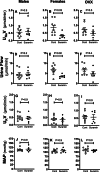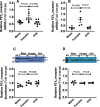Role for ovarian hormones in purinoceptor-dependent natriuresis
- PMID: 32928299
- PMCID: PMC7490965
- DOI: 10.1186/s13293-020-00329-0
Role for ovarian hormones in purinoceptor-dependent natriuresis
Abstract
Background: Premenopausal women have a lower risk of hypertension compared to age-matched men and postmenopausal women. P2Y2 and P2Y4 purinoceptor can be considered potential contributors to hypertension due to their emerging roles in regulating renal tubular Na+ transport. Activation of these receptors inhibits epithelial Na+ channel activity (ENaC) via a phospholipase C (PLC)-dependent pathway resulting in natriuresis. We recently reported that activation of P2Y2 and P2Y4 receptors in the renal medulla by UTP promotes natriuresis in male and ovariectomized (OVX) rats, but not in ovary-intact females. This led us to hypothesize that ovary-intact females have greater basal renal medullary activity of P2 (P2Y2 and P2Y4) receptors regulating Na+ excretion compared to male and OVX rats.
Methods: To test our hypothesis, we determined (i) the effect of inhibiting medullary P2 receptors by suramin (750 μg/kg/min) on urinary Na+ excretion in anesthetized male, ovary-intact female, and OVX Sprague Dawley rats, (ii) mRNA expression and protein abundance of P2Y2 and P2Y4 receptors, and (iii) mRNA expression of their downstream effectors (PLC-1δ and ENaCα) in renal inner medullary tissues obtained from these three groups. We also subjected cultured mouse inner medullary collecting duct cells (segment 3, mIMCD3) to different concentrations of 17ß-estradiol (E2, 0, 10, 100, and 1000 nM) to test whether E2 increases mRNA expression of P2Y2 and P2Y4 receptors.
Results: Acute P2 inhibition attenuated urinary Na+ excretion in ovary-intact females, but not in male or OVX rats. We found that P2Y2 and P2Y4 mRNA expression was higher in the inner medulla from females compared to males or OVX. Inner medullary lysates showed that ovary-intact females have higher P2Y2 receptor protein abundance, compared to males; however, OVX did not eliminate this sex difference. We also found that E2 dose-dependently upregulated P2Y2 and P2Y4 mRNA expression in mIMCD3.
Conclusion: These data suggest that ovary-intact females have enhanced P2Y2 and P2Y4-dependent regulation of Na+ handling in the renal medulla, compared to male and OVX rats. We speculate that the P2 pathway contributes to facilitated renal Na+ handling in premenopausal females.
Keywords: Ovariectomy; Purinoceptors; Renal medulla; Sodium excretion.
Conflict of interest statement
The authors declare that there are no conflicts of interest. Dr. Gohar is also affiliated with the Department of Pharmacology and Toxicology, Faculty of Pharmacy, Alexandria University, Egypt.
Figures





Similar articles
-
Ovariectomy uncovers purinergic receptor activation of endothelin-dependent natriuresis.Am J Physiol Renal Physiol. 2017 Aug 1;313(2):F361-F369. doi: 10.1152/ajprenal.00098.2017. Epub 2017 May 3. Am J Physiol Renal Physiol. 2017. PMID: 28468962 Free PMC article.
-
Activation of purinergic receptors (P2) in the renal medulla promotes endothelin-dependent natriuresis in male rats.Am J Physiol Renal Physiol. 2016 Aug 1;311(2):F260-7. doi: 10.1152/ajprenal.00090.2016. Epub 2016 May 25. Am J Physiol Renal Physiol. 2016. PMID: 27226106 Free PMC article.
-
Potential involvement of P2Y2 receptor in diuresis of postobstructive uropathy in rats.Am J Physiol Renal Physiol. 2010 Mar;298(3):F634-42. doi: 10.1152/ajprenal.00382.2009. Epub 2009 Dec 9. Am J Physiol Renal Physiol. 2010. PMID: 20007349 Free PMC article.
-
Intrinsic control of sodium excretion in the distal nephron by inhibitory purinergic regulation of the epithelial Na(+) channel.Curr Opin Nephrol Hypertens. 2012 Jan;21(1):52-60. doi: 10.1097/MNH.0b013e32834db4a0. Curr Opin Nephrol Hypertens. 2012. PMID: 22143248 Free PMC article. Review.
-
Molecular pharmacology of P2Y-receptors.Naunyn Schmiedebergs Arch Pharmacol. 2000 Nov;362(4-5):310-23. doi: 10.1007/s002100000310. Naunyn Schmiedebergs Arch Pharmacol. 2000. PMID: 11111826 Review.
Cited by
-
Endothelin mediates sex-differences in acclimation to high salt diet in rats.Biol Sex Differ. 2023 Oct 10;14(1):70. doi: 10.1186/s13293-023-00555-2. Biol Sex Differ. 2023. PMID: 37817272 Free PMC article.
References
-
- Labrie F, Labrie C. DHEA and intracrinology at menopause, a positive choice for evolution of the human species. Climacteric. 2013;16:205–213. - PubMed
-
- Carrero JJ, Hecking M, Chesnaye NC, Jager KJ. Sex and gender disparities in the epidemiology and outcomes of chronic kidney disease. Nat Rev Nephrol. 2018;14:151–164. - PubMed
-
- Valdivielso JM, Jacobs-Cacha C, Soler MJ. Sex hormones and their influence on chronic kidney disease. Curr Opin Nephrol Hypertens. 2019;28:1–9. - PubMed
Publication types
MeSH terms
Substances
Grants and funding
LinkOut - more resources
Full Text Sources

